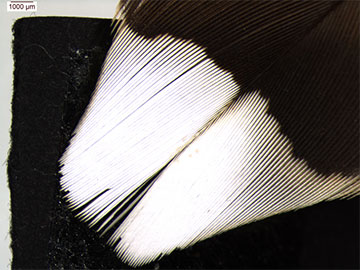![]()
A woodcock in flight, revealing its bright white spots. [Image: J.L. Zimmermann]
The mottled-brown Eurasian woodcock, Scolopax rusticola, is most active at dawn and dusk—low-light periods when visual communication is difficult. Previously, scientists thought that such birds sent messages with sounds or chemicals, instead of the eye-catching plumages used by their daytime-active relatives. Yet many birds that are muted in color for camouflage in daylight have hidden white feathers that could, in principle, convey information in twilight—if they were reflective enough.
Now researchers led by Jamie Dunning, a scientist at Imperial College London, UK, say they have shown that the woodcock has specialized feathers that maximize the light reflected from white patches on the underside of its tail (J. R. Soc. Interface, doi:10.1098/rsif.2022.0920). The team believes that the bird evolved its brilliant white spots, which have diffuse reflectance about 30% higher than that of any previously measured feather, through elaborate macro-, micro- and nanoscale structural modifications to communicate in dimly lit environments.
New techniques, old feathers
The team used scanning and transmission electron microscopy to study museum samples of woodcock tail feathers, which are greyish brown on the top and white on the bottom. The researchers looked specifically at the makeup of the feathers’ rami—protrusions from the feather’s central stem that make up the bulk of its structure, held together by round, Velcro-like structures called barbules.
They found that the white rami are flatter and 2.5 times thicker than the brown rami, and that they overlap each other, similar to Venetian blinds, at angles from 70 to 76 degrees. This shape and arrangement provide an enhanced surface area and angle for reflection, while preventing light from passing between the feather’s barbules. The thicker white rami were also more internally complex, made up of photonic cells with fine, disordered networks of keratin nanofibers and scattered air pockets. These together create numerous interfaces to scatter light that did not appear in the brown rami.

Optical microscopy of the woodcock’s white tail region. [Image: L. D’Alba]
The researchers then used micro- and macro-spectrophotometry to measure the reflectance spectra of the tail feathers, which revealed intense diffuse reflectance on the white underside, peaking at 55% reflectance (at a wavelength of 628 nm). Individual rami had even greater specular reflectance, peaking greater than 100% against a diffuse standard. This is 31% brighter than the next most reflective bird ever measured, the Caspian tern, which peaks at 38% diffuse reflectance.
Finite-difference time-domain (FDTD) simulations provided additional insight on how photons might interact with the feathers’ tiny structures. The modeling suggested that the disordered nanostructure of keratin and air is essential to the intense reflectance, enabling a 65% increase relative to a modeled hollow unit cell. The results also suggested that the broadened rami are set at angles that optimize reflectance at the macro scale—reflectance peaked at an angle of 70 degrees, matching the angle of the rami.
Sending signals
The researchers write that, although studies on other birds have also shown intense white reflectance, the woodcock has “the whitest white plumage patch currently known among the birds.” They suggest that the bright white patches are linked to communication and evolved specifically to allow signaling in low light. The patches are only visible from below, so the bird has to raise and fan the tail for them to be seen—for example, during courtship displays, predator distraction or other non-reproductive communication.
“Bird enthusiasts have long known that woodcocks have these intense white patches, but just how white they are and how they function has remained a mystery,” said lead researcher Dunning. “From an ecological perspective, the intensity of the reflectance from these feathers makes sense—they need to hoover up all the light available in a very dimly lit environment.”

